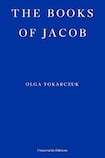
Having written several novels that vary greatly in both style and subject matter, it was reasonable to expect that Olga Tokarczuk – winner of the Nobel Prize in Literature for 2018 – would look to fresh themes and intentions when she began writing The Books of Jacob.
But few would have predicted that she would write a novel of more than 900 pages (with the pages numbered backwards), which concerns itself with the mystical beliefs of 18th-century Jews living in central Europe, the factionalism that develops between them, and the burgeoning transition from spiritualism to materialism of a central messianic character who is, at various times, a Jew, a Muslim, a Catholic and a devout believer in his own exceptional transcendence.
The novel is divided into a number of named books. In the second of these, The Book of Sand, many interesting debates occur between Jewish dissenters, teasing out, for example, “how God can punish us for our sins with hell?” or whether the messiah is female. There is a notable disparity between these people’s boundless beliefs and the reality of their constricted lives, lived in environments hostile to their nomadism.
The desire for possibilities greater than those offered by traditional Jewish beliefs is encouraged by the figure of Jacob, who preaches a strategy of permanent opposition to accepted practices, culminating in a complete rejection of the Talmud and the beginnings of an antagonistic position in which only the complete reversal of all that is prescribed in that sacred text will, he affirms, lead to eternal life. This process is often as startling in its manifestations as it is divisive in its implications. An erotic excitement is let loose, led by the priapic Jacob who is loved by, and loves in return, a great number of women and men.
Even more startling – given that the book was published in Poland in 2014 – are the references to a plague spread by exhalations of air
The discord between the Jews who accept the Talmud and Jacob’s followers who – through his guidance and direction – have begun to be baptised, is exploited by a Catholic clergy whose intellectual and temporal pursuits are richly explored. Belief in the blood libel – the suggestion that the blood of a Christian child was needed for the Passover matzah – is used by both the Catholic Church and the anti-Talmudists for their own ill-motivated purposes.
Much of the argument about the veracity of the libel centres on the translation from Hebrew. It’s a significant reminder of the importance of translators such as Jennifer Croft, who is responsible for this remarkable translation, the length of which, filled as it is with dense chapters that often veer from the central narrative to illuminate secondary characters, may test the patience of some readers. But, for those undaunted, the book offers an unusual level of engagement and perspectives on society and religion, which illuminate both past and present.
All fiction is, unavoidably, written in its own time and the considerations of this novel are often recognisably those of our present. The adulation of Jacob and his consequent arrogance shape into a recognisable sense of contemporary celebrity. Descriptions of people massing on borders hoping to cross into other countries resonate across the centuries. Even more startling – given that the book was published in Poland in 2014 – are the references to a plague spread by exhalations of air and people’s precautionary wearing of face coverings.
Jacob’s preoccupation with ostentatious displays of luxury leads the novel away from considerations of spiritual beliefs towards examinations of moral decay and the malleability of faith. Interesting though this section of the book is, the change in focus lessens the exploration of the discrepancy between the expectations of his followers – especially their assumption of imminent advancement towards eternal life – and the experiences of their actual lives.
What matters is the internal coherence of the world she creates through language and her ability to guide us through examinations of limitless faith and human failings
It may seem greedy to wish for more in a novel of such length, but one of the most interesting characters, and the book’s one element of magic realism, is a woman called Yente. We meet her at the beginning, swallowing a piece of paper that prevents death from fully taking hold of her. Yente’s benign, drone-like ability to float above the landscape, observing who she wishes, allows an objective view of the manipulative actions of Jacob and others. She is the spirit of the novel, but her potential to be a pivotal character is never fully realised.
That many of the events Tokarczuk narrates are derived from historical sources is fascinating but essentially unimportant. What matters is the internal coherence of the world she creates through language and her ability to guide us through examinations of limitless faith and human failings, cultural identity and the ostracism of the other, the manipulation of the steadfast and the thoughtless cruelty of friends.
Above all, she shows us our enduring search for meaning. This extraordinary novel is part of that search.
















